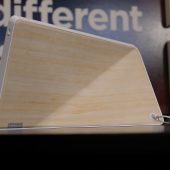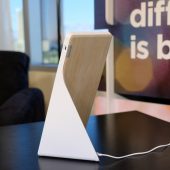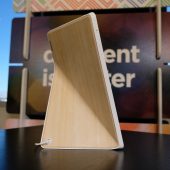Voice assistants on our phones, from Google to Alexa to Siri, have gone from novelties to key parts of our daily workflow. Up until now, with the exception of the Amazon Echo Show, they’ve been stuck solely on phones, tablets, and speakers.
Lenovo is smashing everyone’s perception of a digital assistant with the Smart Display, which will quickly become the main hub of your home. The Smart display one-ups the Amazon Echo Show by offering larger screen options, and instead of Alexa, it’s focused on Google Assistant integration.
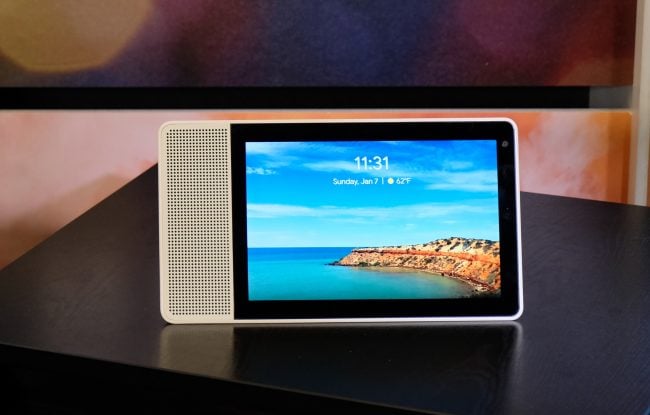
Photo: Chloe Becquet/GearDiary
Smart Display is so much more than a speaker with a screen tacked on… it is a complete reimagining of how a smart assistant can change your life, and it is specifically designed to run your home.
For starters, it can use photos as a screensaver, so when it is idle, you have a beautiful digital frame. In addition, Smart Display offers “voice match,” meaning it will know from voice which family member is talking and tailor responses and information accordingly.
And there’s a lot of personalization built into the Smart Display because it is all powered by Google Assistant; if your calendar, maps, photos, etc, are through Google, it can use all that information to provide an even more tailored experience.
Best of all, it looks quite attractive, with a metal front and clean design that fits into any aesthetic. It comes in two sizes, 8″ and 10″ [$199 and $249, respectively), and the larger one also has a bamboo backing for an even more polished look. Lenovo also made sure these had a full HD display, so everything will look sharp and clear.
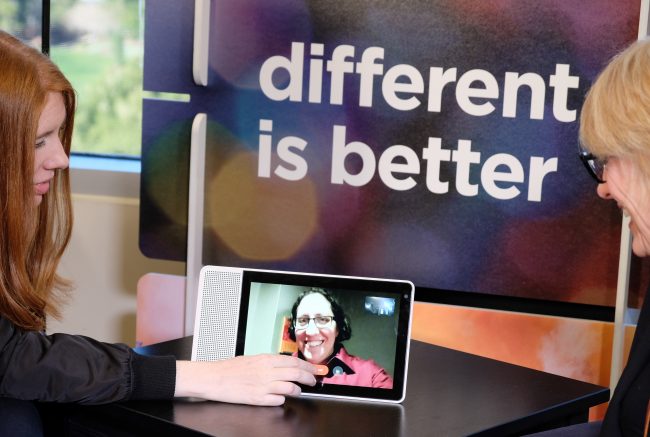
Photo: Chloe Becquet/GearDiary
Here’s an idea of how Smart Display can change your entire approach to home and technology. Google Assistant is going to be picking up a new feature called “routines,” where a keyword sets off a series of reports from the Smart Display.
Let’s say you set your routine keywords as “Good Morning.” Once Smart Display hears that command, it could reel off all sorts of important information: the time, the weather for the day, how long my commute could take, my calendar for the day, and today’s top news.
All of this would also cycle up on the screen, so you get a visual of the weather, traffic, calendar, and then videos for the news. If you want to do some cooking, have the Smart Display pull up a recipe, and then it can read you the recipe steps as well as swing you to videos if you need technique tips for anything.
- Photo: Chloe Becquet/GearDiary
- Photo: Chloe Becquet/GearDiary
- Photo: Chloe Becquet/GearDiary
It’s more than just making a few commands easier, however. Smart Display also has Google Duo built in, so a quick “call ____” triggers a video call.
If you’re looking at information on a potential destination (restaurant, store, etc), saying “how do I get there?” pulls up directions, which means Smart Display is context-aware.
It is smart enough to know what and why you are asking for certain things, and that removes many of the friction points that have made digital assistants difficult in the past (how many times have you seen someone yell at Siri for not understanding?).
If you have a Nest Cam, you can pull up a video feed, plus Smart Display will also work with YouTube TV, so Lenovo sees this as being a replacement for a small kitchen tv or a tablet that you might prop up for entertainment while doing dishes, etc.
And, of course, the Smart Display will handle all manner of smart home devices, like turning on and off the lights, controlling the thermostat, or turning on the sprinklers on command as your annoying neighbor walks by with his dog.
The Smart Display is so much more than just a beefed-up Google Assistant experience. This is the future of the smart home and likely the future of mobile in general.
You can pull up directions on your Smart Display and shoot them over to your phone when you leave the house. You can snap photos on the go, and they’re available on your Smart Display.
As Google learns more about your preferences, interests, and calendar, the Smart Display can do an even better job of tailoring the news, recipes, and other suggestions to precisely what you require.
If you’ve ever used Google Now, you’re familiar with how Google can use its algorithms to figure out what you need; what kind of news you read, what TV shows you enjoy, recipes you like to cook, etc, all become part of the suggestions in the feed, and the Smart Display will do the same.
Digital assistants are becoming the killer feature that changes how you interact with your devices. It is both more natural and more efficient to speak a question than to pull out your phone and type a query or hunt for your music app and then search for the playlist or album you want.
Having a central hub that can do all that right from your home brings together all the modular pieces and takes it from novelty to utility. This has the chance to change smart homes in the same way the iPhone changed smartphones.
The killer feature of the iPhone wasn’t specifically the OS or the design; it was the idea that literally anyone could pick up the phone and understand how to use it.
We watched Lenovo demo the Smart Display, and literally just about anyone could learn to use this with a minimal to non-existent learning curve. Simplicity, ease of use, and a reasonable price are what will drive widespread adoption. Smart Display nails that and absolutely has the potential to completely change the way we interact with our homes, phones, music, and lives. Look for it this summer!

